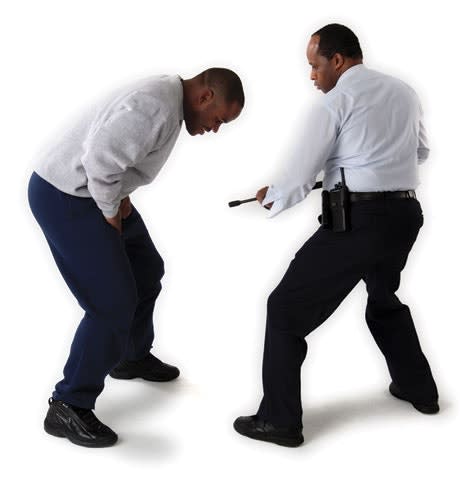To overcome, you employ defensive tactics skills such as blocks, counterstrikes, and less-lethal weapons, including aerosol OC, expandable and fixed batons such as PR-24s, and energy conducted devices (ECD). An empty hand block, for example, can parry a suspect's hostile grab to the outside. You can follow that move with a counterpunch to the suspect's torso, which is sufficient enough to overcome the suspect's initial attack.
You might also use a baton to overcome a suspect. First, you have to create and maintain some distance from a menacing suspect to allow for further situational assessment. Then you can take the initiative with empty hands or by drawing an expandable or fixed baton. Create or maintain a reactionary gap from a suspect using one of six primary patterns of movement: forward such as shuffle or pivot step, lateral such as side step right or left, or back such as shuffle or pivot step. In most straight-on attacks, your best dodge would be a lateral move since it usually leads to a position of advantage to the outside of a suspect's body. While moving, reach across your body to grab and then draw your baton. This is a "cross draw" under the Monadnock system. The cross draw allows you to actively defend with one hand while grabbing the baton with the other. This technique gives you greater dexterity, strength, and balance than drawing that same baton when it's positioned behind the holstered weapon. Note: Whenever your hands move back and pass the midauxiliary line, your balance can be adversely affected. Your range of movement is also reduced when you are trying to remove your baton from its holder.
Now that the baton is ready for service, you can employ any number of blocking, counterstriking, and subject-control skills in three distinctive zones of defense.
At extended range (Zone 3), most baton systems are pretty much equally useful since there is a forward or reverse strike or spin. But if the suspect is not deterred and advances closer into intermediate range (Zone 2), few baton systems have as many counterstriking, blocking, or subject-control skills available to an officer as found in Monadnock training. This is also true at close range (Zone 1), the most critical survival zone because it extends just one foot from an officer's chest.
[PAGEBREAK]












